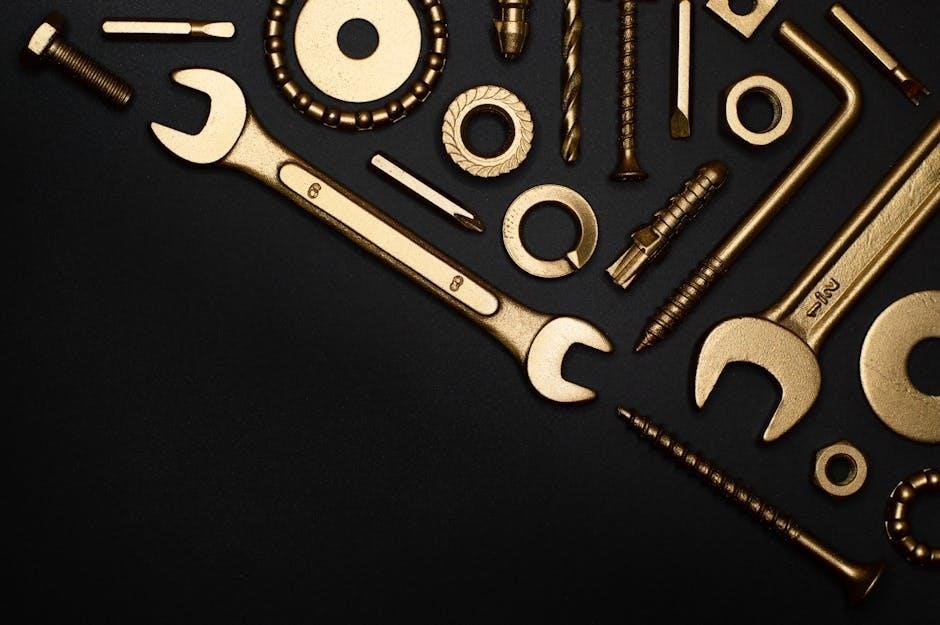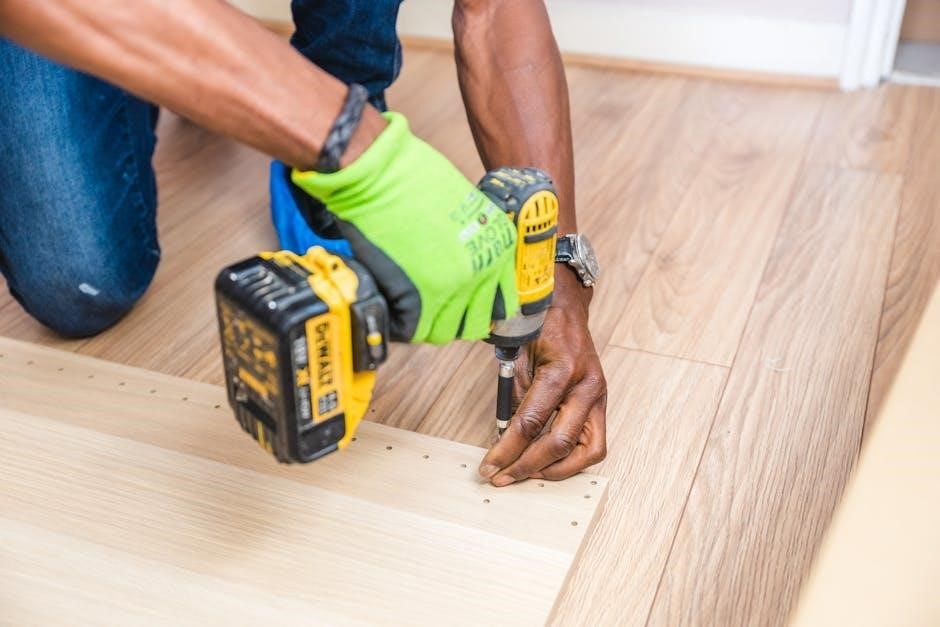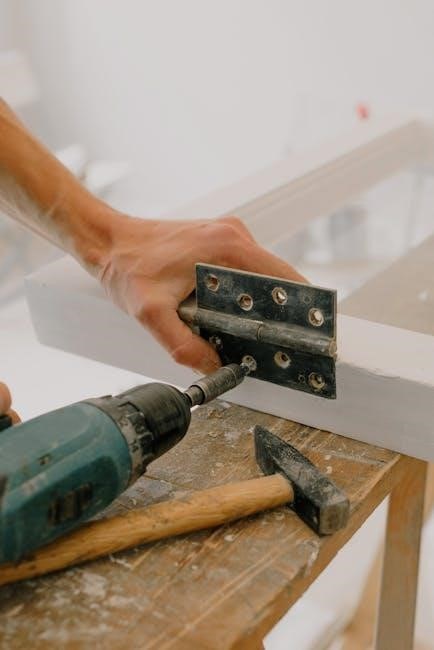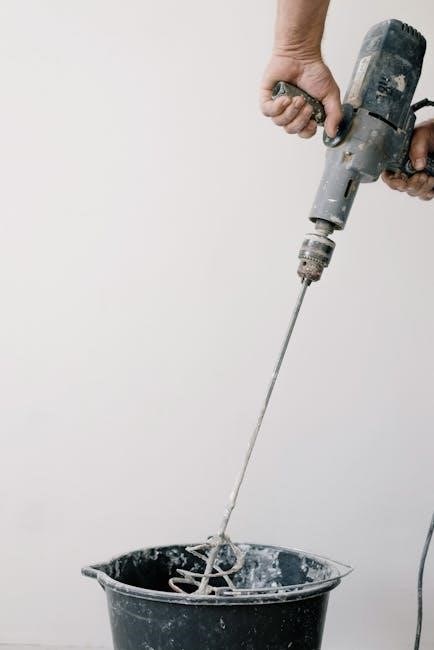A drill and tap guide is an essential reference tool in manufacturing, helping to achieve accurate hole drilling and threading. It ensures consistency and precision in operations.
1.1 What is Drilling and Tapping?
Drilling involves creating holes in materials using drill bits, while tapping refers to threading those holes for screws or bolts. Both processes require precision and alignment to ensure proper fit and function. Drilling is typically done first to create a pilot hole, followed by tapping to cut threads. Using guides and charts helps achieve accurate results, especially when calculating drill sizes for specific tap diameters. Proper techniques ensure durability and prevent errors in manufacturing applications.
1.2 Importance of Drill and Tap Guide in Manufacturing
A drill and tap guide is essential for ensuring precise hole creation and threading in manufacturing. It provides standardized drill and tap sizes, reducing errors and material waste. This guide helps manufacturers select the correct tools and techniques, ensuring consistent and accurate results. By following the guide, production becomes more efficient, and the risk of faulty parts is minimized. It is a critical resource for maintaining quality and reliability in industrial applications.

Understanding the Basics of Drilling and Tapping
Drilling creates holes, while tapping adds threads for screws. Both processes require precision to ensure proper fit and function in manufacturing applications.
2.1 Types of Drills and Their Uses
Drills vary in design to suit specific tasks. Twist drills are the most common, used for general-purpose drilling in metal, wood, and plastic. Spade drills are ideal for large holes, while forstner drills create precise, flat-bottom holes in wood. Counterbore drills combine drilling and countersinking for flush fasteners. Each type is tailored to material and application, ensuring efficiency and accuracy in manufacturing and DIY projects. Selecting the right drill is crucial for achieving desired results.
2.2 Types of Taps and Their Applications
Taps are classified based on their functionality and usage. Hand taps are manual tools for threading small holes, while machine taps are designed for power-driven operations, ensuring high precision. Pipe taps create internal threads in pipes and fittings. Taper, plug, and bottoming taps are used for specific threading depths. Each type is tailored for different materials and applications, ensuring efficient thread production in manufacturing and mechanical projects. Proper tap selection is essential for achieving accurate and durable results.
2;3 Difference Between Drill and Tap
A drill is used to create holes in materials, while a tap is designed to cut internal threads in pre-drilled holes. Drills have a single point and flutes for removing material, whereas taps have threads to form screw threads. Drills operate at higher speeds but lower torque, while taps require lower speed and higher torque for precise thread cutting. Both tools are essential but serve distinct purposes in manufacturing processes, ensuring proper hole creation and thread formation for secure fastening solutions.

Choosing the Right Tools for Drilling and Tapping
Selecting the right tools involves considering material type, tool quality, and size. Proper tool selection ensures accuracy, efficiency, and prevents damage to the workpiece or tool itself.
3.1 Selecting the Correct Drill Bit for the Job
Selecting the correct drill bit is crucial for achieving precise and efficient results. Consider the material being drilled, such as metal, plastic, or wood, and the desired hole size. Twist bits are versatile for general drilling, while spade bits are ideal for large holes in wood. Forstner bits are best for clean, flat-bottomed holes. Coated bits, like titanium nitride, reduce friction and extend tool life. Always match the drill bit type to the project requirements to ensure accuracy and minimize wear.
3.2 How to Choose the Right Tap for Your Project
Selecting the right tap involves considering the material, thread type, and size. Taps are designed for specific materials, such as metal, plastic, or wood. Straight-flute taps are suitable for most metals, while spiral-flute taps excel in deep-hole tapping. The thread size and pitch must match the bolt or screw being used. Coated taps, like titanium nitride, reduce wear in demanding applications. Always ensure the tap matches the drill bit size for precise threading. Proper selection ensures efficient and accurate thread cutting.

Safety Best Practices for Drilling and Tapping
Always wear safety goggles, gloves, and ensure workpieces are securely clamped. Maintain a clean workspace and avoid loose clothing that could catch in tools. Proper training is essential for safe operations.
4.1 Essential Safety Equipment for Drill and Tap Operations
To ensure safety, essential equipment includes safety goggles to protect eyes from debris, a face mask to prevent inhalation of dust or metal particles, and steel-toe boots for foot protection. Gloves are crucial to maintain grip and prevent hand injuries. An apron or protective clothing safeguards against flying particles. Hearing protection is necessary for loud machinery. Proper ventilation in the workspace is also vital to avoid inhaling harmful fumes or lubricants. Always ensure equipment is in good condition to prevent accidents during operations.
4.2 Safe Operating Procedures to Avoid Injuries
Always clamp the workpiece securely to prevent movement during drilling or tapping. Wear loose clothing and tie back long hair to avoid entanglement. Use the correct speed for the material being worked on. Maintain a firm grip on the tool and apply steady, consistent pressure. Never reach over moving parts, and keep bystanders away. Regularly inspect tools for wear or damage. Ensure proper training on equipment and techniques to minimize errors and injuries during operations.

Measurement and Alignment in Drilling and Tapping
Accurate measurement and alignment are critical for precise drilling and tapping, ensuring holes and threads are correctly positioned and sized for optimal results and safety. Proper tools and techniques guarantee success.
5.1 How to Accurately Measure for Drilling and Tapping
To ensure accuracy, use precision tools like calipers or micrometers to measure material thickness and hole locations. Mark centers clearly with a center punch to guide drills. Double-check measurements against blueprints or specifications. Use jigs or fixtures to maintain consistency, especially for complex projects. Align tools perpendicular to the workpiece to avoid angled holes. Verify tap drill sizes using charts to match thread dimensions. Always measure twice and drill once to prevent costly errors.
5.2 Importance of Proper Alignment in Drill and Tap Operations
Proper alignment is crucial for achieving precise, straight holes and accurate threads. Misalignment can lead to crooked holes, uneven threads, and potentially damaged tools or workpieces. Correct alignment ensures the drill bit and tap enter the material squarely, reducing the risk of tool breakage and improving surface finish. It also minimizes vibration, which can cause inaccurate results. Proper alignment is essential for maintaining the integrity of the material and ensuring the functionality of the final product.

Using a Drill and Tap Chart
A drill and tap chart is essential for standardizing hole and thread dimensions, ensuring compatibility between drill bits and taps. It provides a quick reference guide for selecting the correct tool sizes, enhancing efficiency and accuracy in manufacturing processes. Proper use of the chart guarantees consistency, reducing errors and improving overall product quality. It is a vital resource for both professionals and hobbyists working with metal and other materials.
6.1 How to Read and Understand a Drill and Tap Chart
To read a drill and tap chart, start by identifying the drill size column, which lists standard drill bit diameters. Locate the corresponding tap size row, ensuring compatibility with the drill. Match the thread pitch to the desired fastener specification. Pay attention to major and minor diameters for precise alignment. Use the chart to determine the correct pilot hole size for threading. Always verify units (inches or millimeters) to avoid sizing errors. Proper interpretation ensures accurate hole drilling and threading, enhancing safety and efficiency in manufacturing processes.
6.2 Benefits of Using a Drill and Tap Chart for Accuracy
Using a drill and tap chart ensures precise hole diameters and thread dimensions, reducing errors. It streamlines the selection process, saving time and improving efficiency. Consistent results are achieved by aligning drill and tap sizes. The chart minimizes material waste and enhances safety by preventing oversized holes or incorrect threading. It also aids in maintaining uniformity across multiple projects, ensuring compliance with specifications. This tool is essential for professionals seeking high accuracy and reliability in drilling and tapping operations.

Material-Specific Drilling and Tapping Techniques
Drilling and tapping techniques vary by material, requiring specific tools and methods for metals, plastics, and wood to ensure accuracy and prevent damage.
7.1 Drilling and Tapping in Metal
Drilling and tapping in metal require careful consideration of material properties. Harder metals like steel and titanium need high-speed steel (HSS) or carbide tools for durability. Aluminum and softer metals may require specialized coatings to reduce wear. Proper lubrication is essential to prevent overheating and extend tool life. Using flood coolant or mist systems can improve precision and surface finish. Understanding the specific needs of each metal type ensures accurate and efficient drilling and tapping operations.
7.2 Drilling and Tapping in Plastic
Drilling and tapping in plastic demand careful handling to avoid melting or deforming the material. Use sharp, high-speed steel (HSS) or carbide-tipped drill bits to minimize heat buildup. Apply lower drill speeds and maintain steady pressure to prevent the plastic from melting. For tapping, use taps designed specifically for plastics to avoid splitting. Ensure the workpiece is securely held to maintain stability. Consider material-specific considerations, as different plastics have varying hardness and flexibility. Using appropriate techniques ensures clean, precise holes and threads in plastic materials.
7.3 Drilling and Tapping in Wood
Drilling and tapping in wood require careful technique to prevent splintering or uneven surfaces. Use sharp, wood-specific drill bits, such as spade or forstner bits, for clean holes. Maintain steady pressure and moderate speeds to avoid damaging the material. For tapping, wood taps or self-tapping screws are often used, but ensure the wood is pre-drilled accurately. Keep the workpiece secure to maintain stability. Regularly sharpen tools to prevent tearing wood fibers. Proper alignment and controlled drilling ensure precise results in woodworking projects.

Common Mistakes to Avoid in Drilling and Tapping
Common mistakes in drilling and tapping include using incorrect tools, misalignment, and insufficient lubrication. Proper techniques and maintenance are crucial to avoid issues and ensure precision.
8.1 Drilling Oversized Holes
Drilling oversized holes is a common mistake that can lead to inaccurate tapping and compromised thread quality. This often occurs due to improper drill bit selection or excessive drill pressure. Always use the correct drill bit size specified for the tap to maintain precision. Misalignment or lack of a pilot hole can also result in larger-than-intended holes. To prevent this, ensure proper alignment and use a pilot hole when necessary. Consistent drilling pressure and regular tool maintenance are essential to avoid this issue and achieve desired results.
8.2 Misalignment of Drill and Tap
Misalignment between the drill and tap can result in poor thread quality or tap breakage. Proper alignment ensures the drill bit and tap are perfectly concentric, avoiding uneven threads. Use a pilot hole to guide the drill and maintain accuracy. A drill press is recommended for precise alignment. Always secure the workpiece firmly to prevent movement during operations. Misalignment can also occur from improper setup or uneven surfaces, so ensure the workpiece is level and stable. Using a jig or fixture can help achieve consistent alignment for complex projects.
8.3 Inadequate Lubrication During Tapping
Inadequate lubrication during tapping can lead to increased friction, causing taps to break and damaging the workpiece. Metal fragments can also fuse to the tap, creating a difficult cleanup process. Proper lubrication reduces heat and wear, ensuring smoother thread cutting. Always use appropriate cutting oils or coolants, especially for hard materials like steel or titanium. Insufficient lubrication can result in poor thread quality or tool failure, making the process inefficient and costly. Regular application ensures optimal performance and prolongs tool life.

Lubrication in Drilling and Tapping
Lubrication is crucial in drilling and tapping to reduce friction, prevent overheating, and extend tool life. It ensures cleaner cuts and prevents material damage.
9.1 Importance of Lubrication in Drill and Tap Operations
Lubrication is essential in drilling and tapping to reduce friction and prevent overheating, protecting both the tool and material; It enhances surface finish by ensuring clean cuts and prolongs tool life by minimizing wear. Proper lubrication also boosts process efficiency, enabling smoother operations and more precise outcomes. Inadequate lubrication can lead to tool damage, poor finish, and increased downtime, highlighting its importance for optimal and reliable results in drilling and tapping processes.
9.2 Types of Lubricants for Drilling and Tapping
Various lubricants are used in drilling and tapping, each suited for specific materials and operations. Cutting oils, such as mineral or synthetic oils, are ideal for metalworking, reducing heat and friction. Water-based coolants are effective for high-speed operations, preventing overheating. Dry lubricants like graphite or molybdenum disulfide are used for non-metallic materials. Semi-synthetic and synthetic fluids offer superior performance in demanding applications. Selecting the right lubricant ensures optimal tool life, surface finish, and process efficiency, catering to the unique needs of different drilling and tapping tasks.
9.3 How to Apply Lubrication Effectively
Effective lubrication in drilling and tapping requires careful application. Always apply lubricant continuously during the operation to prevent overheating and tool wear. Use the correct amount—excessive lubricant can be wasteful, while too little may lead to inefficiency. Apply directly to the cutting edge or workpiece interface. For manual operations, use a brush or spray bottle. In automated systems, ensure coolant flows steadily. Maintain proper pressure to distribute lubricant evenly. Clean the workpiece afterward to remove residue and ensure accuracy.

Advanced Drilling and Tapping Techniques
Advanced techniques involve high-precision methods such as CNC machining and lathe operations, utilizing specialized tools for various materials to ensure accuracy and efficiency in complex manufacturing projects.
10.1 Using a Lathe for Precision Drilling and Tapping
A lathe enhances precision by enabling stable workpiece rotation, allowing for accurate alignment and control during drilling and tapping. It is ideal for intricate designs requiring exact hole placement and threading. The lathe’s rigidity minimizes vibration, ensuring consistent results. Operators can achieve precise depths and diameters, making it essential for high-tolerance applications. This method is particularly effective for complex geometries and materials like metals, where precision is critical. Proper setup and skilled operation are key to maximizing accuracy and efficiency in lathe-based drilling and tapping operations.
10.2 CNC Machining for High-Precision Drill and Tap Operations
CNC machining provides exceptional accuracy and consistency in drilling and tapping by utilizing computer-aided designs. This automated process minimizes human error, ensuring precise hole placement and threading. Ideal for intricate designs, CNC machines efficiently handle various materials, from metals to plastics. They offer faster production rates and reduced material waste, making them cost-effective for high-precision manufacturing. This technology is indispensable for achieving superior quality and reliability in complex drill and tap projects.
Understanding drilling and tapping is essential for precise and efficient manufacturing. Proper tools, materials, and techniques ensure high-quality results, while safety and precision remain paramount throughout the process.
11.1 Summary of Key Points
Drilling and tapping are fundamental processes in manufacturing, requiring precise tools and techniques. Proper drill and tap selection, material consideration, and safety practices ensure efficiency and accuracy. Understanding the differences between drills and taps, along with correct lubrication and alignment, minimizes errors. Using charts and advanced techniques enhances precision, while avoiding common mistakes like oversized holes or inadequate lubrication guarantees superior results. Following these guidelines leads to successful and professional drill and tap operations.
11.2 Final Tips for Successful Drill and Tap Operations
Always use high-quality tools to ensure precision and durability. Regularly maintain drills and taps to prevent wear. Follow drill and tap charts for accurate hole and thread sizes. Apply material-specific techniques for optimal results. Wear safety gear to protect against debris and injuries. Use consistent pressure to avoid tool breakage. Properly lubricate to reduce friction and extend tool life. Double-check alignment and measurements before starting. Avoid common mistakes like over-tightening or using incorrect speeds. These practices guarantee professional-grade drill and tap outcomes every time.
